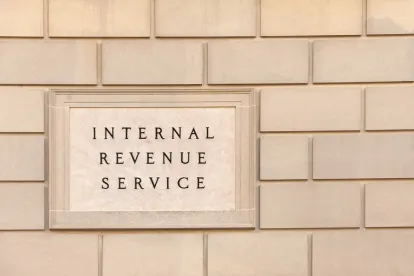On June 24, 2020, the Internal Revenue Service (the “IRS”) and the U.S. Department of Treasury (“Treasury”) issued final regulations (the “Final Regulations”) on the application of the “passthrough deduction” under Section 199A[1] to regulated investment companies (“RICs”) that receive dividends from real estate investment trusts (“REITs”). The Final Regulations broadly allow a “conduit” approach, through which RIC shareholders who would have been able to benefit from the deduction on a dividend directly received from a REIT can take the deduction on their share of such dividend received by the RIC, so long as the shareholders meet the holding period requirements for their shares in the RIC. This confirms the approach of proposed regulations issued in February 2019 (the “Proposed Regulations”), on which RICs and their shareholders were already able to rely. Additionally, the preamble to the Final Regulations (the “Preamble”) notes that the IRS and Treasury continue to decline to extend conduit treatment to qualified publicly traded partnership (“PTP”) income otherwise eligible for the deduction. Please read the remainder of this post for background, a description of the technical provisions of the Final Regulations, and a brief discussion of policy issues discussed in the Preamble.
Background
Section 199A was enacted as part of the 2017 tax reform act, commonly referred to as the TCJA.[2]Where it applies, Section 199A provides individuals (and certain trusts and estates) with a so-called “passthrough deduction” of up to 20% that, in effect, reduces their rate of tax on ordinary income items to as low as 29.6% (in the case of those otherwise taxed at the maximum ordinary rate of 37%). The eligible ordinary income items include (i) the combined “qualified business income” of a U.S. trade or business operated as a sole proprietorship or through a partnership, S corporation, trust or estate (i.e., a “passthrough” entity), (ii) certain REIT dividends, and (iii) certain PTP income. Section 199A expressly extends the passthrough deduction benefit to qualified REIT dividends[3]and qualified PTP income[4] derived through partnerships and “S” corporations, but did not on its face extend such treatment to REIT dividends and PTP income derived through a RIC, even if passed through to the RIC’s shareholders by allocation and notation on the IRS Form 1099-DIV the RIC provides to its shareholders on an annual basis.
RICs are corporations for U.S. tax purposes and, thus, not themselves eligible for the benefits of Section 199A. However, a RIC often functions as a financial conduit. A RIC is typically managed so as to not pay entity-level tax – instead, it pays out all (or nearly all) of its income to its shareholders in the form of qualifying dividends and is eligible to deduct those dividends from its own income. The income items generally flow through to the RIC’s shareholders, who report and pay U.S. federal income tax on their proportionate share of the RIC’s income. As a result, many have argued that the benefits of Section 199A ought to be extended to qualifying income earned through a RIC (essentially, treating a RIC as eligible to itself pass through a passthrough deduction to its shareholders).
Passthrough deduction for qualified REIT dividends paid by a RIC
As was the case in the Proposed Regulations, the Final Regulations generally allow RICs to pass through to a non-corporate shareholder qualified REIT dividends eligible for the passthrough deduction. More specifically, any dividend that a RIC pays to its shareholders and reports as a “Section 199A dividend” is eligible for the passthrough deduction to the extent it is derived from the aggregate amount of qualified REIT dividends includible in the RIC’s taxable income for the taxable year less expenses properly allocable to the qualified REIT dividends. Generally, most dividends made by a REIT in the ordinary course of business are qualified REIT dividends. Dividends attributable to capital gains, such as from the sale or exchange of underlying REIT assets or dividends taxed as net capital gain under Section 1(h)(11), do not qualify (those dividends are already taxed at a lower rate). Shareholders of the RIC are required to hold the dividend-paying share for at least 46 days of the 91-day period beginning 45 days before the share becomes ex-dividend, and are prohibited from being under an obligation to make related payments with respect to a position in substantially similar or related property.
A RIC is not required to account for and allocate any Section 199A dividends to its shareholders, even if the RIC derives eligible income to do so. This is consistent with the approach taken to specifically allocable RIC income in other contexts (such as interest-related dividends paid to non-U.S. shareholders and foreign tax credits).[5] The Final Regulations require RICs that do choose to allocate dividends eligible for the passthrough deduction to keep certain detailed records of their investment portfolio in order to trace income that may be eligible for the Section 199A deduction. This obligation may create administrative costs for a RIC. A RIC that derives (or may derive in the future) a material amount of REIT-related income should consider carefully how to address Section 199A in any disclosure document provided to current or potential future shareholders.
Application of Section 199A to PTP dividends and other income earned by RICs
The Final Regulations do not extend conduit treatment under Section 199A to qualified PTP income derived through RICs, even though the reasons for doing so are arguably similar to those for allowing qualified REIT dividends to benefit from such treatment. The Preamble states that, as a general principle, overall economic performance is improved to the extent that the tax consequences of investment through a financial intermediary (such as a RIC) are equivalent to the tax consequences of direct investment. In the absence of these regulations, a tax incentive would arise for individuals to invest directly in REITs rather than through RIC intermediaries. While there would not appear to be any reason why this logic would not apply equally to investments in PTPs, the Preamble states that the IRS and Treasury continue to decline providing guidance on this issue.
The IRS and Treasury also acknowledged the efficiency of taxpayers’ investing through RICs rather than directly into REITs, noting that, “[t]he same level of investment can be achieved with substantially less resource use if research costs are incurred by RICs rather than individual investors….”
One possible reason for the difference in treatment of PTP dividends from REIT dividends is that calculating and tracking the former may prove to be more complex for a RIC than the latter.
The Preamble states that the IRS and Treasury are continuing to consider “whether it is appropriate and practicable to provide conduit treatment for qualified PTP income or other income of a RIC to further the purposes of section 199A(b)(1)(B).”
Notes
[1] All references to “Section” are references to the Internal Revenue Code of 1986, as amended.
[2] Pub. L. No. 115-97, 115 Stat. 2054 (2017).
[3] For purposes of Section 199A, a dividend from a REIT is a “qualified REIT dividend” that qualifies for the passthrough deduction if: (i) it is received during the taxable year, (ii) it is not a capital gain dividend, (iii) it is not qualified dividend income, (iv) it is received with respect to a share of REIT stock that is held more than 45 days during the 91-day period which begins 45 days before the ex-dividend date, and (v) the shareholder is not under an obligation to make payments under a swap with respect to the dividend or otherwise obligated to make “related payments” with respect to positions in “substantially similar or related property.” Treas. Reg. Section 1.199A-3(c)(2).
[4] “Qualified PTP income” for purposes of Section 199A is the sum of a taxpayer’s net allocable share of income, gain, deduction and loss from a PTP that is not taxable as a corporation, plus any gain or loss attributable to unrealized receivables and inventory items of the PTP that give rise to ordinary income, which are attributable to the trades or businesses conducted by the PTP. Treas. Reg. Section 1.199A-3(c)(3); Sections 751(a) and (b).
[5] See Sections 852(b), 854(b) and 871(k) (designation of “qualified interest income” as “interest-related dividends”); Section 853 (election to pass through foreign tax credits to shareholders).
Christine N. Younger also contributed to ths article.








 />i
/>i

